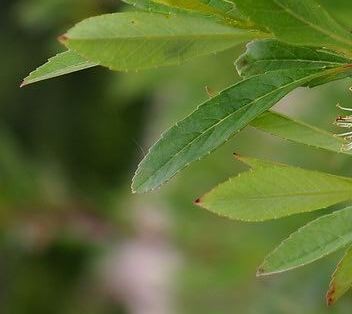Sand cherry
(Prunus pumila)

Description
Prunus pumila, commonly called sand cherry, is a North American species of cherry in the rose family. It is widespread in eastern and central Canada from New Brunswick west to Saskatchewan and the northern United States from Maine to Montana, south as far as Colorado, Kansas, Indiana, and Virginia, with a few isolated populations in Tennessee and Utah. It grows in sandy locations such as shorelines and dunes. Prunus pumila is a deciduous shrub that grows to 2-6 feet tall depending on the variety. It forms dense clonal colonies by sprouts from the root system. The leaves are leathery, 4–7 centimetres (1.6–2.8 in) long, with a serrated margin. The flowers are 15–25 millimetres (0.59–0.98 in) in diameter with five white petals and 25–30 stamens. They are produced in small clusters of two to four. The fruit is a small cherry 13–15 millimetres (0.51–0.59 in) diameter, ripening dark purple in early summer. Prunus is a genus of trees and shrubs, which includes (among many others) the fruits plums, cherries, peaches, nectarines, apricots, and almonds. Native to the northern temperate regions, 430 different species are classified under Prunus. Many members of the genus are widely cultivated for their fruit and for decorative purposes. Prunus fruit are drupes, or stone fruits. The fleshy mesocarp surrounding the endocarp is edible while the endocarp itself forms a hard, inedible shell called the pyrena ("stone" or "pit"). This shell encloses the seed (or "kernel") which is edible in many species (such as almonds) but poisonous in others (such as apricots). Most Prunus fruit are commonly used in processing, such as jam production, canning, drying, and seeds for roasting. Members of the genus can be deciduous or evergreen. A few species have spiny stems. The leaves are simple, alternate, usually lanceolate, unlobed, and often with nectaries on the leaf stalk along with stipules. The flowers are usually white to pink, sometimes red, with five petals and five sepals. Numerous stamens are present. Flowers are borne singly, or in umbels of two to six or sometimes more on racemes. The fruit is a fleshy drupe (a "prune") with a single relatively large, hard-coated seed (a "stone"). Within the rose family Rosaceae, it was traditionally placed as a subfamily, the Amygdaloideae (incorrectly "Prunoideae"), but was sometimes placed in its own family, the Prunaceae (or Amygdalaceae).
Taxonomic tree:







